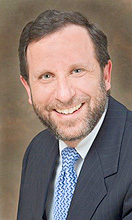News
An innovative idea to eradicate polio
-
 Print
Print -
 Comments
Comments
-

“Open innovation allows individuals to contribute to fields that normally would be considered outside their area of expertise.”
A UB clinical professor is one of five winners of an international crowdsourcing contest held to develop new approaches to polio vaccination that finally will rid the planet of the disease.
Crowdsourcing harnesses the “wisdom of the crowd” to solicit innovative ideas to society’s most intractable problems from beyond the boundaries of the professionals traditionally tasked with solving them.
Harvey Arbesman, clinical assistant professor in the Department of Dermatology, School of Medicine and Biomedical Sciences and a winner of other high-profile biomedical challenges, was one of five solvers whose ideas for how to eradicate polio were chosen as the best for implementation.
Following the success of this initial challenge, BeyondPolio, the organization that sponsored the challenge, is investigating ways to accelerate development and testing of the proposed ideas.
“The challenge was to come up with new opportunities for an inexpensive way to accomplish mass polio vaccination that have been overlooked by major organizations, such as the World Health Organization,” Arbesman says.
The goal is to create an inexpensive, injectable vaccine for use in low- and middle-income countries that would be ready for use by 2017, with all immunizations in the world complete by 2020.
Right now, Arbesman explains, vaccination programs in these countries use the oral polio vaccine; because it consists of live polio virus, two out of every million children who are vaccinated will develop polio, providing a reservoir for the virus.
By contrast, the injection only uses dead virus, which would allow polio to be completely eradicated from the planet.
But it’s still too expensive.
“My idea used my knowledge of dermatology and the skin to combine some things that were already out there but that might have been overlooked by the polio-vaccine research community,” Arbesman says. His proposal recommended using an immune stimulating patch that is easily applied to the skin after injection of the vaccine. This approach theoretically could decrease the cost of the polio vaccine significantly, while maintaining or even increasing its effectiveness.
It was a winner.
“Open innovation challenges encourage ideas from people outside of the generally accepted way of approaching the problem, as a way to think outside the box,” says Arbesman, who also is a clinical assistant professor in the Department of Social and Preventive Medicine, UB School of Public Health and Health Professions. “Open innovation allows individuals to contribute to fields that normally would be considered outside their area of expertise. This approach offers great promise for solving many important problems facing the world.”
The contest was organized by the open innovation company InnoCentive for BeyondPolio, a collaboration of the Jonas Salk Legacy Foundation and Spencer Trask & Co. that is dedicated to eliminating polio. BeyondPolio plans to conduct future challenges and promote collaborative programs, and is actively seeking partnerships with corporations, foundations and others who can bring support, resources and attention to enhance these efforts.
With his wife, Marian Arbesman, Arbesman runs ArbesIdeas, an open innovation company for the life sciences based in Williamsville. In 2007 and 2009, Arbesman won crowdsourcing contests for developing a promising biomarker for Lou Gehrig’s disease, or ALS. In 2010, he was named a Top Solver in the InnoCentive Solver community.

Reader Comments